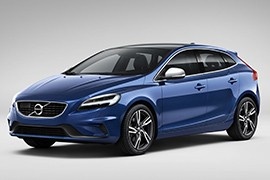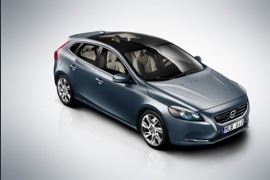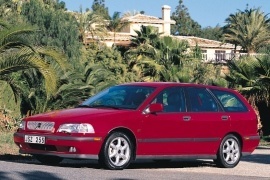
VOLVO V40
Generations Timeline, Specs and Pictures

Volvo introduced a facelift for the 2012 V40 and while it slightly improved the car’s look, it greatly improved its fuel-efficiency and carbon footprint.
The first generation of the V40 was introduced in 1995 as a station-wagon version of the S40 sedan, a vehicle built in cooperation with Mitsubishi at NedCar in the Netherlands. After 2004, that lineup ended, and there was a gap until 2012 when Volvo returned on the market with the V40. This time it was based on Ford’s C-Global platform used for the Focus range. In 2016, Volvo introduced a facelifted version.
Volvo started to work hard under the new Chinese ownership. The engineers were not limited to work with Ford parts only and with some rules that they couldn’t understand. In the end, the designers took the lead and drew a car to fill the needs of a compact-sized station wagon and as a hatchback as well. The clean, minimalist style design featured few attractive ideas such as the T-shaped daytime running lights within the headlights and the lower bumper shape. A wide grille with vertical slats and the diagonal bar for the Volvo logo adorned the front fascia.
There were subtle changes on the door-mirrors casings from its sides, where the turn-signals were longer than on the non-facelifted version. In the rear, the taillights’ flowing line was similar, and it took an expert eye to separate the 2016 model from its non-facelifted brother.
Volvo installed some new engines under the hood and decreased its offer to just six from eight as it featured on the non-facelifted version.

The V40 was released in 2012 and was a great alternative to the VW Golf and the A3 Sportback.
With the Swedish brand well known for the safe cars they produce, the V40 also came with a cutting-edge design. The V40 was one of the best looking cars in its segment at the time.
The coupe design was eye-catching and most of the styling cues were borrowed from the C30 coupe, giving it a rather sporty and sleek look.
Inside, the V40 was as pleasing as it was on the outside. The dashboard was of a minimalist design and practicality wasn’t left aside. The cabin was equipped with lots of storage places to increase comfort.
The V40 was equipped with the Volvo’s City Safe system. Hitting a pedestrian would be rather hard in a V40 with the car braking by itself.
Great design, great safety features, but that was not all.
The comfort the V40 offered was among the best. The seats were designed for the users to enjoy lots of kilometers on the motorway without feeling tired.
The handling was good, as well as the precise steering made the V40 a fun car on twisty roads.
The cabin was quiet overall and a bit of a tire roll could be heard at higher speeds.

Volvo introduced the V40 in 1996 after signing an agreement with Mitsubishi, but after joining Ford Motor Company in 1999, it introduced a facelift for the entire range.
The Swedish carmaker offered the V40 more as a lifestyle station-wagon, which was different from those built to move a student to college from one trip, including its desk and closet. It was made for families who enjoyed spending time outdoors, with plenty of room in the back to store a tent and roof-rails on top to hold a canoe.
Four years after it was introduced on the market, the V40 went through a facelift that brought new bumpers, headlights, and new taillights. Ford already had a bigger experience in how to facelift a vehicle and improve it in front of its customers and helped its new partner. It advised the Swedish carmaker to add new light-alloy wheels and new safety systems. Volvo was already known for its safe vehicles.
Inside, there were minor changes to the cabin. On the center stack, the climate control panel was replaced. There was a new stereo, which featured an in-dash CD-player. Volvo improved the look of the instrument panel as well, by adding larger LCDs on the bottom of the speedometer and tachometer for the on-board computer info and the odometer.
Under the hood, the carmaker introduced a few new engines, with direct fuel-injection turbodiesel units provided by Renault. Another significant upgrade was for the automatic gearbox, which received a fifth-gear that lowered the engine noise at highway speeds and improved fuel-efficiency.

Volvo signed an agreement with Mitsubishi to produce cars together at the NEDCAR factory in the Netherlands, and the result was the S40/V40 lineup.
Volvo’s commitment to switch to a front-wheel-drive system continued with the first generation of the S40/V40. But its experience in that area was limited, so it asked other carmakers for help. Thus, the Swedish carmaker introduced a new range in its stable in 1996, using the letter S for sedans and V for station wagons.
With the S40/V40 range, Volvo closed the wedge-design chapter. The new car offered smooth lines and slightly curved body panels. At the front, the bumper featured a lower apron where the carmaker integrated the fog lights. Its horizontal headlights featured smoothened corners on the upper side, flanking the chromed grille with vertical slats. On its sides, the car revealed its family-oriented shape, with an extended roof behind the rear doors. The rear side offered more of a hatchback-style than a Volvo station-wagon type, with a raked-forward tailgate.
Inside, the carmaker installed a dashboard with smooth lines and a center stack that hosted the HVAC controls on the upper side and the radio-cassette player at the bottom. Volvo used a green light illumination in the instrument cluster, showing the speedometer in the middle and the tachometer on the left. Its five-seat cabin offered good room for the front passengers and adequate for the rear ones. The trunk provided 471 liters (16.6 cu-ft) of space with the rear seats up and up to 1421 liters (50.2 cu-ft) with them folded.
Under the hood, the Swedish carmaker installed a wide engine choice either built by Volvo or Mitsubishi (the 1.8-liter direct-injected gasoline unit) or Renault (the 1.9-liter turbo-diesel).























































